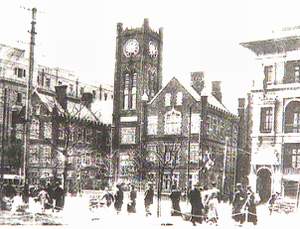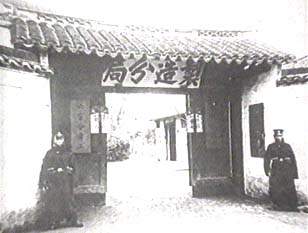 |
|
Troubled Times at the Beginning of the Century (3)
Carved Up  |
|
|
 Shanghai is a metropolis of highly representative significance in China. Here is the estuary of the Yangtze, the longest river in the country. It is the biggest Chinese port facing the Pacific Ocean. It was a small county unknown to the world before the middle of the 19th century. Since then it has become the largest city in the Far East. Shanghai is a metropolis of highly representative significance in China. Here is the estuary of the Yangtze, the longest river in the country. It is the biggest Chinese port facing the Pacific Ocean. It was a small county unknown to the world before the middle of the 19th century. Since then it has become the largest city in the Far East.
This was the Bund in Shanghai 130 years ago. It could hardly be related to the metropolis with many high-rise buildings constructed later.
After Shanghai became a port city, the Westernization Movement initiated mainly by bureaucrats of the Qing Dynasty in the latter half of the 19th century to introduce techniques of capitalist production and the flourishing trade between China and other countries built up a solid material foundation for the city. The Opium War of 1840 taught Empress Dowager Cixi the word “settlement”. The first settlement was established in Shanghai five years later. It covered an area of about 55 hectares. In 1899, the International Settlement alone covered more than 2,000 hectares. Cixi could not be unaware that it was a humiliating loss of sovereignty for the Qing government.
In 1900, Shanghai was becoming a developed modern city. Its prosperity attracted more and more foreigners. From films made in those days, we can see colourful scenes of Shanghai at the beginning of the 20th century. Almost all the fashionable goods could be found here. An American reporter said that Rome had not been built in a single day, but Shanghai had been so.
Nanjing Road was the busiest street in the settlements. From these photos we could see the development of Nanjing Road. The rise and decline of a road was an epitome of the process of modernization in China.
The Chinese quarters of the city were under the jurisdiction of the Qing government. Their area was much smaller than that of the settlements. The court trial followed the way of the feudal dynasty, but foreigners in the settlements enjoyed extraterritorial rights and privileges.
 The building of the Maritime Customs Bureau rebuilt in 1927 was a representative building in Shanghai. It was the office of the Inspector General of the Maritime Customs Bureau of China. The facade was exactly like a town hall in Britain. It was a proof of Britain’s influence in the Customs House. The building of the Maritime Customs Bureau rebuilt in 1927 was a representative building in Shanghai. It was the office of the Inspector General of the Maritime Customs Bureau of China. The facade was exactly like a town hall in Britain. It was a proof of Britain’s influence in the Customs House.
Robert Hart from Britain was the Inspector General of the Maritime Customs Bureau of China for 48 years. According to a press report in 1862, Britain took from Shanghai a surprising amount of silver equivalent to 13 million pounds, one half of Britain’s GNP in 1856.
Shanghai was the capital of many foreigners in China. Somebody even said that Shanghai was a key to the door of China.
In fact, Shanghai was an epitome of humiliation suffered by China.
Towards the end of the Qing Dynasty, a young painter drew the Chart of the Political Situation, vividly depicting how China had been carved up by the imperialist powers. Japan had forcibly occupied Taiwan. Tsarist Russia had stretched out its hands to Northeast China. Britain had attempted to split Xinjiang and dominated Yunnan Province exclusively. Germany had invaded and occupied the eastern part of Shandong Province. France was coveting large tracts of territory in South China. For many other countries, China was probably only a geographical concept and it allowed itself to be trampled on. The political caricature illustrated the carving up of China.
|
|
|
|
|
|
|
 |









